List of Authors
>>About this blog
Recent blog post
|
[kimitaku]
October 3, 2015 14:00
"There are many customers who visit Tsukishima for sightseeing.
But many customers eat "Monja", so I'm not satisfied with Tsukishima. "
What, Kannon of Tsukishima was saying ...?
Before I put the monja into my stomach.
When you go along the alley to the bathhouse, you will see the lucky Kannon quietly.
Throw the offer and ask quietly, gently squat down and look at the picture in the box. There are a lot of pictures of the fire extinguisher.
Just like each one, isn't the youngshu welcomes you with a stick behind it? Please take a look.
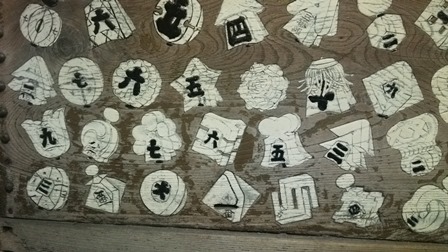
[Tachibana]
18:00 on October 2, 2015
Speaking of Mitsubishi, it's "Marunouchi", but when it comes to Mitsui it's "Muromachi". Mitsukoshi is also a Mitsui group, and the head office of Toray was located in the place where "Coredo Muromachi 1" is currently located. Currently, we moved our headquarters to Nihonbashi Mitsui Tower, but Toray doesn't have the name Mitsui, but it's Mitsui.
Actually, I would like to introduce the company I worked for because the head office was in the Mitsui Main Building before the war.
After the former Mitsui Main Building completed in 1902 was damaged by the Great Kanto Earthquake, Mitsui Main Building ordered construction from James Stuart in the United States with the intention of building a highly earthquake-resistant building under the leadership of Takuma Dan, who was the director of Mitsui's joint company. Construction was completed in 1929. It is designated as an important cultural property of Japan.
The design is "splendid", "quality", and "simplicity", and is expressed by adding a Rome-style colint-style large order column to the American neoclassical design to the three sides of the building.
The exterior is made of granite, and the design is made of plenty of marble.
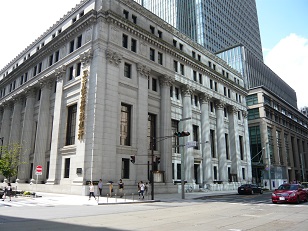
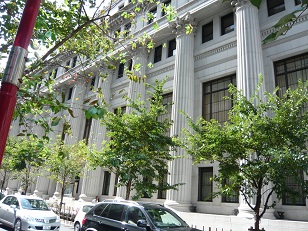
In addition, the interior is luxurious, and red carpets are laid on stairs and corridors.
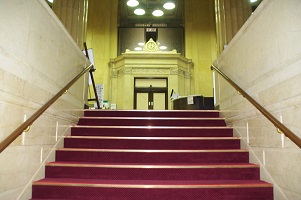
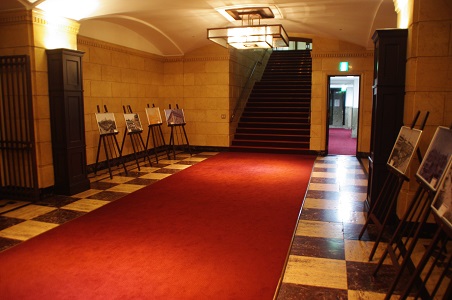
In addition, the large space of the atrium with a doris-type cylindrical group on the first floor is also very luxurious.
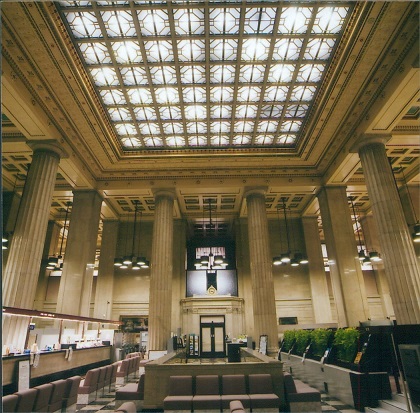
In the basement, there is a large safe with a door of 90 cm wide and weighing 50 tons.
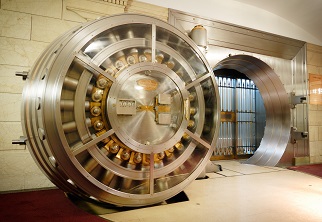
It seems difficult to break the safe with this.
In fact, the door of this safe was too heavy, and it was said that it was carried by boat without permission to pass over Nihonbashi.
There is an episode left.
The current Mitsui Main Building has been completed for more than 90 years, and Takuma Dan was shot by a blood member in front of the entrance.
After World War II, we have seen sad events such as being requisited by GHQ.
At present, the area around Muromachi is bustling, with Chored Muromachi opening, and Fukutoku Shrine being rebuilt finely.
The Mitsui Main Building will continue to monitor the transition of Muromachi.
(Inside photos were provided by Sumitomo Mitsui Trust Bank.)
[Gin Tangeron]
16:00 on October 2, 2015
Using high-quality paper, a corner of Ginza Street with a pale touch is drawn at the top of one page, and Ginza Town Magazine has a charm that attracts people.
"Ginza Times" was discontinued in the August issue.
Since it was first published in 1947, I think it was still a birth in a burnt field.
He must have been staring at Ginza for 68 years and making a great contribution.
The Ginza love column posted by readers was literally filled with content related to Ginza, and it was a very fun corner.
From such an article, I wanted to join him, but I ended up without realizing my thoughts.
When I applied for the present in the last issue, I received a special furoshiki from the Chuo-ku Tourism Association.
Every time you look at this furoshiki, it is inevitable to remember Ginza Times.
[Sumida Fireworks]
09:00 on October 2, 2015
Shinohashi is one of the bridges that span the Sumida River. This bridge, which features an orange main tower, is located one upstream of Kiyosu Bridge, and connects Nihonbashihamacho in Chuo-ku to Morishita in Koto-ku. It is a relatively new bridge built in 1977 (Showa 52).
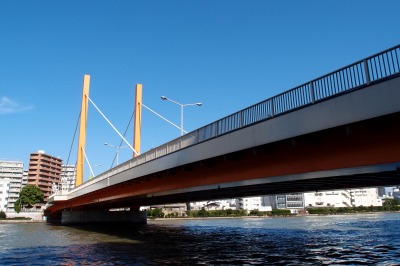
This time, it is the story of the previous bridge, an old iron bridge built over the current location in 1912 (Meiji 45), but this bridge is a rigid form called the truss bridge, but it has an elegant decoration. It is said that it was a bridge (the photo below shows the old bridge attached to the main tower of the current bridge).
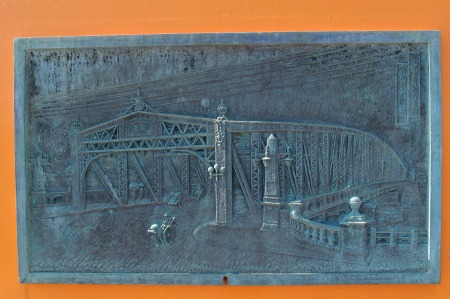
Part of this old bridge is preserved and displayed as a registered Tangible Cultural Property in Meiji Mura in Inuyama City, Aichi Prefecture. I've always wanted to go to Meiji-mura, but finally my wish came true and I went to see this Silver Week.
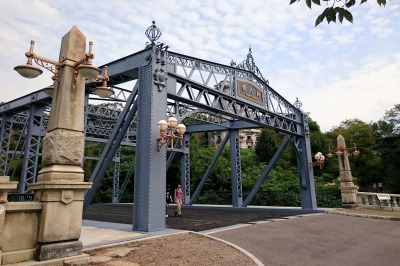
At first glance, it was an impression that it was surprisingly large. About one-eighth of the Nihonbashihamacho side has been relocated to Meiji Village, but if you imagine that it was simply eight times as large as it was on the Sumida River, it was quite large at that time I think it was.
It is 173 meters long and 25 meters wide, and it seems that streetcars began to pass shortly after opening, and the traces have been reproduced in this Meiji village.
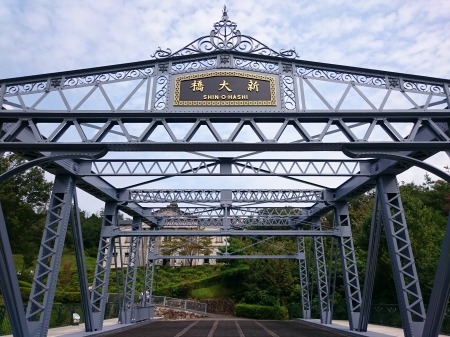
Also, the decoration that is a characteristic of this bridge. It was more delicate and beautiful than I expected. The bridge itself is heavy, so you may feel more like that. The most surprising thing was the bridge nameplate written by Motosuke Nomura. The color is gorgeous after passing through the elegant.
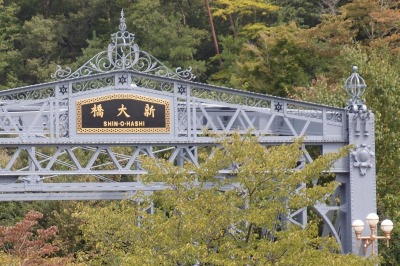
It seems that the colors of the bridge nameplate, lighting fixtures and sidewalk railings were previously painted with gray paint, but it was repainted in the spring of this year to restore it to the color at the time of construction (The photo below shows the decoration of the railing of the sidewalk that incorporates many curves).
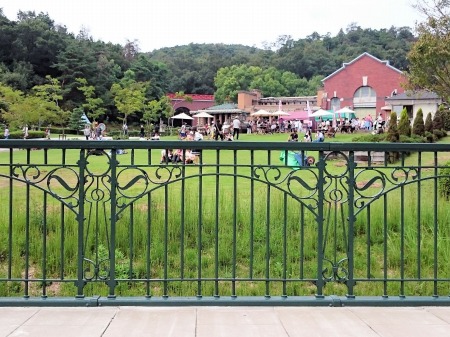
The white granite railings and main pillars are made of majesty.
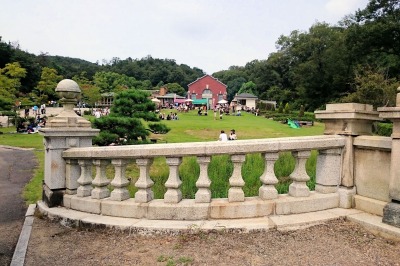
This old bridge was built during the Meiji era, but what is often mentioned was events during the Great Kanto Earthquake.
As other bridges fell in the earthquake, this bridge, which was relatively new at the time, did not fall, did not burn, saved many lives of the crowds who flooded this bridge. For this reason, it has come to be called "Human Help Bridge" or "Help Bridge".
At the side of the current bridge on the Chuo-ku side, there are the "Great Earthquake Evacuation Monument" and the "Humansuke Bridge Origin Monument".
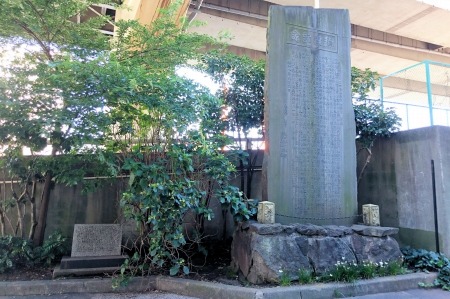
The "Great Earthquake Evacuation Monument" is bigger than I expected and looks up. This may be a sign of the great appreciation of the people of the time for this bridge.
It was built in 1933, ten years after the Great East Japan Earthquake, and it is written that many refugee was saved because of the power of the gods of neighboring shrines who had been evacuated to this bridge and the power of those who made appropriate decisions to throw away their luggage.
On the other hand, the smaller one, "Monument of the Origin of the Human Assistance Bridge", is a monument built when the old bridge was replaced by the current bridge. At the time of the earthquake, it is described in honor of the appropriate judgment of police officers working at Shinohashi Nishizume Police Station at Hisamatsu Police Station.
At the same time as guiding a large number of refugee, he determined that all refugee would be burned down and dumped burning luggage into the Sumida River, saving more than 10,000 lives.
However, I think the best reason is that this bridge was also an excellent bridge for disaster prevention.
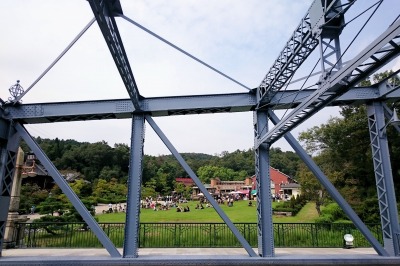
It seems that Meiji Village is the 50th anniversary of this year. Such historically valuable buildings are left as actual materials, can be seen and felt. I think it's a wonderful thing.
I came here and felt that when rebuilding buildings and buildings, not just bridges, it is necessary to make efforts to pass them on to future generations.
[CAM]
16:00 on October 1, 2015
Kafu also describes "Minami Takahashi", "Toyomi Bridge", etc. The Toyomi Bridge over the Nihonbashi River was completed in September 1927, and the Minami Takahashi over the Kamejima River was completed in March 1932.
On June 14, 1934, "After Hakozaki-cho, cross Toyomi Bridge, and walk Echizenbori Riverside Street." There is a small shrine in Kawaguchi, Shinkawa. I'm going to spend my forehead with the Tokai Shrine. I don't know what God is. Walk along the riverbank, pass Minatomachi, stand on Minami Takahashi and Ifu Bridge, and see you leave the wharf of steamships bound for Oshima. We reach Ginza by shared car and go to the Ginza Shokudo."
Toyomi Bridge (taken on September 23, 2015, the same applies hereinafter)
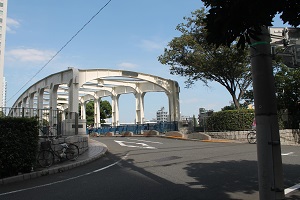
"Minami Takahashi" was also written on June 26.
On June 26, 1934, "Sure Temushi Atsushi". Writing in the afternoon. We go to the twilight Ginza and eat dinner at the Ginza restaurant. It appears on the side of the tall building of Matsuzakaya over 7 o'clock. old calendar I wish May. Take a shared car from Kabukizamae, get off the car in front of the gunpowder Inari, cross Minami Takahashi, reach the landing wharf in front of Echizenbori Warehouse, sit on the stone and watch the famous moon. The factory in Ishikawajima shines brilliantly with lights and is a state of prosperity. There are two or three steamers on the water bound for Izu Oshima. There are two or three men and women who look at the moon on the wharf. The boatman's voice, who often hangs on the shores. Walk and go to the Tonbo Tofu family in oyster shell town, take a bath and return home."
In Minami-Takahashi, there is a signboard that quotes Shokutei Nijo, but it is July 1934, and the moon display is incorrect for some reason.
Minami Takahashi
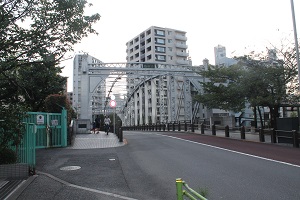
"Tokai Shrine" is Inari Shrine located in Shinkawa, Chuo-ku. It is reported that the Inari Shrine, which was named Tokay, was first enshrinemented in 1704 (1704) in 1704 (1704) because it was burned down in ancient document due to the Great Kanto Earthquake and the Great Teijin Air Raid. (From the Tokyo Shrine Directory)
"Echizenbori" is the current Shinkawa 1-2-chome area, the old town name. During the Edo period, this area was the site of Echizen Fukui feudal lord and Matsudaira Echizen Mamoru. The mansion is surrounded on three sides by entrances, which was called "Echizenbori". In the Meiji era, the site of Echizen Mamoru became the town name "Echizen Hori", but the moat was gradually reclaimed. After the Great Kanto Earthquake of 1923 (1923), most of them were reclaimed, leaving a part, and the slightly remaining parts near the Sumida River were completely reclaimed after the war. After that, the name of the town was changed, and it became "Shinkawa" to the present day. Now, the name of "Echizenbori", which survives the past, is only found in Echizenbori Park here.
"Tetsuguni Inari Shrine" is located in Minato, Chuo Ward. The date of its establishment is unknown, but it is said that it was founded in Seiwa 8 (841) and was founded in the Shokyu period (1219-1221). Around 1624 (1624), it was transferred to the southeastern end of Inaribashi and was called Hatchobori Inari. In 1868 (1868), the gunshot was relocated to the area because it became a foreign settlement.
Teppozu Inari Shrine and Fujizuka in the precincts
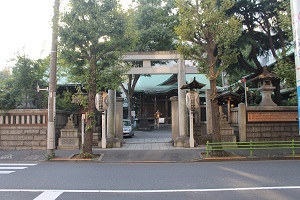
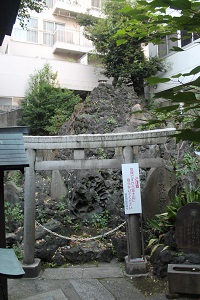
|
Links
|
















